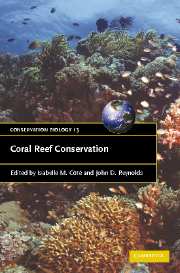Book contents
- Frontmatter
- Contents
- List of contributors
- Foreword
- Preface
- Part I Setting the stage
- Part II Uses and abuses: ecological and socio-economic issues
- 5 Challenges and accomplishments towards sustainable reef fisheries
- 6 Live food and non-food fisheries on coral reefs, and their potential management
- 7 Tourism and coral-reef-based conservation: can they coexist?
- 8 Longer-term impacts of climate change on coral reefs
- Part III The way forward: tools and approache
- Index
- Plate section
- References
8 - Longer-term impacts of climate change on coral reefs
Published online by Cambridge University Press: 05 June 2012
- Frontmatter
- Contents
- List of contributors
- Foreword
- Preface
- Part I Setting the stage
- Part II Uses and abuses: ecological and socio-economic issues
- 5 Challenges and accomplishments towards sustainable reef fisheries
- 6 Live food and non-food fisheries on coral reefs, and their potential management
- 7 Tourism and coral-reef-based conservation: can they coexist?
- 8 Longer-term impacts of climate change on coral reefs
- Part III The way forward: tools and approache
- Index
- Plate section
- References
Summary
INTRODUCTION
Most accounts of coral bleaching rarely take the story further than an initial report of the event, yet it has become clear that longer-term effects may occur at several scales: those of the corals themselves, of the wider ecological community which is based upon the corals and the three-dimensional reef structure they create, and of the human communities which depend on the coral ecosystem for food, wave protection or tourism-related revenues. Several factors change profoundly in areas where mass mortality follows coral bleaching, as was particularly evident following the severe warming event of 1998. During this period, substantial proportions of corals were killed on reefs throughout the tropics, but most particularly in the Indian Ocean where mortality was commonly 50–100% in shallow water. This chapter describes and predicts some of the consequences of changes induced by coral mortality.
First, I clarify two definitions. The distinction is emphasized between coral bleaching and coral mortality. These two terms are commonly conflated, perhaps because they have a clear relationship (McClanahan, 2004). In this chapter, bleaching (perhaps obviously) refers to the blanched appearance of corals following zooxanthellae expulsion. This state may last from days to several months, and a bleached coral may recover, or it may die. Where recovery occurs, the bleaching story usually ends simply – indeed it may never really have started other than at the coral's own physiological level. When bleached corals die in large numbers, however, as seen in 1998, changes become considerable at all scales.
- Type
- Chapter
- Information
- Coral Reef Conservation , pp. 264 - 290Publisher: Cambridge University PressPrint publication year: 2006
References
- 5
- Cited by



